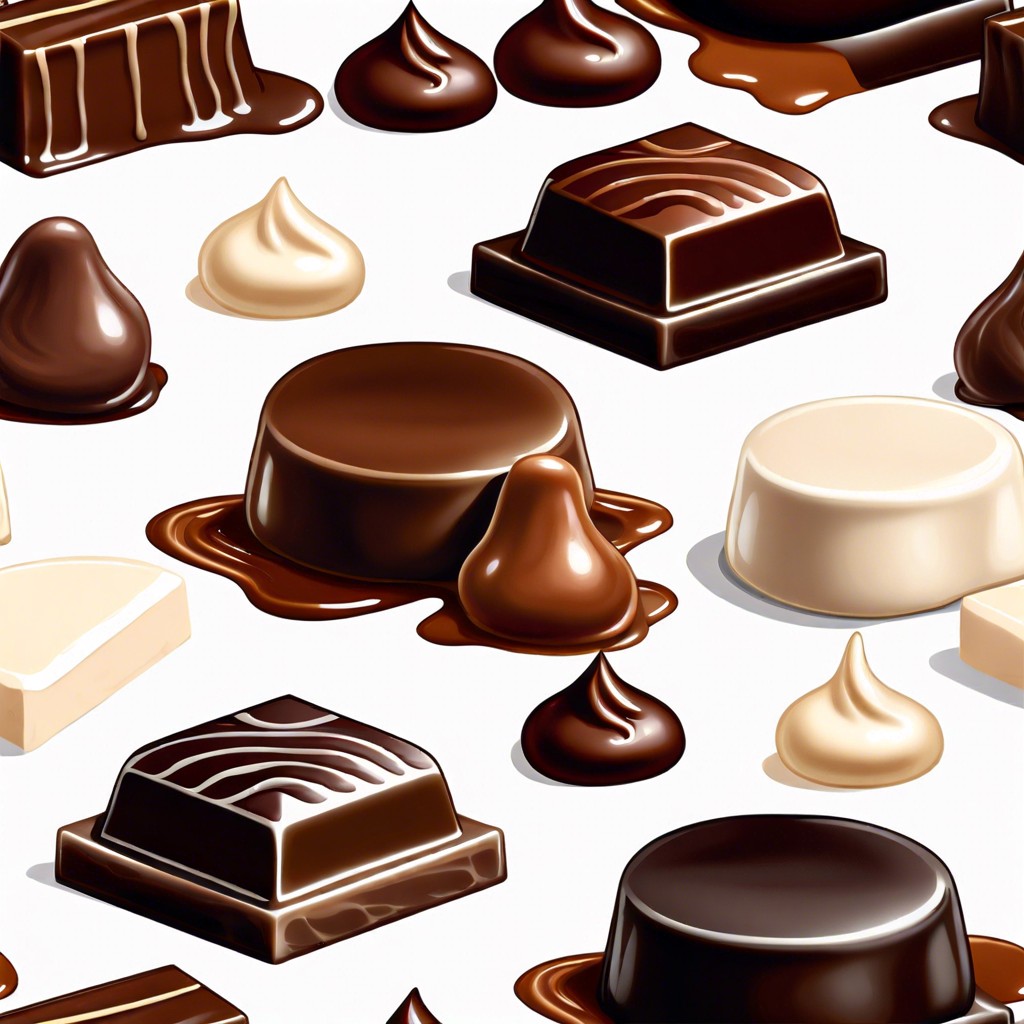Learn about the temperature at which chocolate melts and how to achieve the perfect consistency for your culinary creations.
Key takeaways:
- Milk chocolate melts between 86°F and 113°F (30°C to 45°C).
- Dark chocolate melts between 114°F and 120°F (46°C to 48°C).
- White chocolate melts between 86°F and 110°F (30°C to 43°C).
- Heat chocolate gently to avoid grainy texture.
- Cocoa butter’s melting point determines chocolate’s texture and consistency.
Inside
Melting Points for Different Chocolates

Every chocolate variety dances to its own tune when it comes to melting. Milk chocolate, for instance, softens at about 86°F (30°C) and fully melts between 104°F and 113°F (40°C to 45°C). With a higher cocoa butter content, it’s like the easygoing friend – not too fussy and pretty adaptable.
Dark chocolate, the intense cousin in the family, requires a bit more patience, melting completely at slightly higher temperatures, typically between 114°F and 120°F (46°C to 48°C). Its complexity comes from higher cocoa and lower milk content.
Last up, white chocolate. This one can be a bit of a diva because of its delicate cocoa butter and milk solids, making it prone to heating issues. Aim for gentle warmth around 86°F to 90°F (30°C to 32°C) to start the process, leading up to a fully melted state at around 104°F to 110°F (40°C to 43°C).
Keep these figures in a handy spot in your kitchen. They will guide you to chocolate heaven, ensuring those desserts and confections turn out perfect every time.
Milk Chocolate Melting Point
Gentle warmth is all you need to turn a solid bar of milk chocolate into a pool of creamy delight. With a lower melting point between 86°F (30°C) and 88°F (31°C), it cozies up to body temperature, making it perfectly palatable. The presence of milk solids and sugar plays a role in reducing its melting point compared to dark chocolate. Remember, patience is key. A slow and steady heat source, like a water bath, is your best friend here. Apply too much heat too quickly, and you’ll be bidding adieu to a smooth texture in favor of a grainy chocolate greeting. Heat-sensitive as it is, milk chocolate begs for your gentle touch and a hint of TLC to preserve its silky demeanor.
Dark Chocolate Melting Point
Rich and intense, dark chocolate typically softens between 115 and 120 degrees Fahrenheit (46-49 degrees Celsius). Thanks to its higher cocoa content and lower amount of dairy, it boasts a slightly higher melting threshold than milk chocolate.
For chocolatiers and hobbyists alike, striking the perfect balance when heating dark chocolate is a playful dance between solidity and liquidity. This subtle interplay is essential to ensure that the chocolate melts evenly, without burning.
A hot tip for enthusiasts aiming to melt dark chocolate is to chop it evenly. Smaller pieces allow for more uniform heating, reducing the risk of overheating some while waiting for larger chunks to melt. Once melted, it should display a glossy sheen and smooth consistency, a tell-tale sign that it’s ready to be transformed into decadent creations.
White Chocolate Melting Point
White chocolate behaves a bit differently from its darker counterparts because it lacks cocoa solids. Its melting point hovers around 37°C (98-99°F), just below body temperature. This lower threshold can be attributed to its higher content of cocoa butter and milk solids. Cocoa butter melts easily, making white chocolate more susceptible to overheating.
To avoid a grainy disaster, heat it gently. An ideal approach is using short intervals in the microwave at a reduced power or employing a water bath that’s warm, not hot. Keep a vigilant eye, as white chocolate transitions from solid to liquid with little warning.
Think of white chocolate like a quirky friend — it needs a bit more attention and finesse, but the rewards, like perfectly smooth and silky results, are worth the extra care. Remember, patience is your ally here. Rushing the process invites a mess, and nobody invites a mess to their kitchen party.
The Science of Melting Points
Chocolate’s melting point hinges on its composition, where cocoa butter plays a pivotal role. Cocoa butter contains various fats that melt at different temperatures, which explains why chocolate doesn’t melt uniformly.
In fact, these fats, called triglycerides, consist of fatty acid chains with distinct melting points. When the temperature hits the right mark, these chains break away from their rigid structure, transforming the chocolate from a solid to a luscious liquid.
Temperature precision is critical. Chocolate’s melting point generally falls between 86°F (30°C) and 90°F (32°C), creating a narrow window that demands careful heat control. Surpassing these temperatures may cause chocolate to burn, losing its smooth texture and rich flavor.
Remember, the melting point also signals the chocolate’s structural stability. It is why your chocolate bar doesn’t puddle in your hand the moment you pick it up. It holds its shape, only yielding to the warmth when the temperature is just right. Understanding this delicate balance is essential for anyone looking to master the art of chocolate.
Related
- What Temperature Does Chocolate Melt – Quick Guide to Melting Points
- How to Thin Melted Chocolate: Easy Method for Smooth, Flowing Chocolate
- How to Melt White Chocolate: Easy Steps for a Smooth Result
- How to Make Melted Chocolate Thinner: Simple Techniques for Smooth Results
- What is White Chocolate Made Out Of: Unveiling Its Sweet Secrets